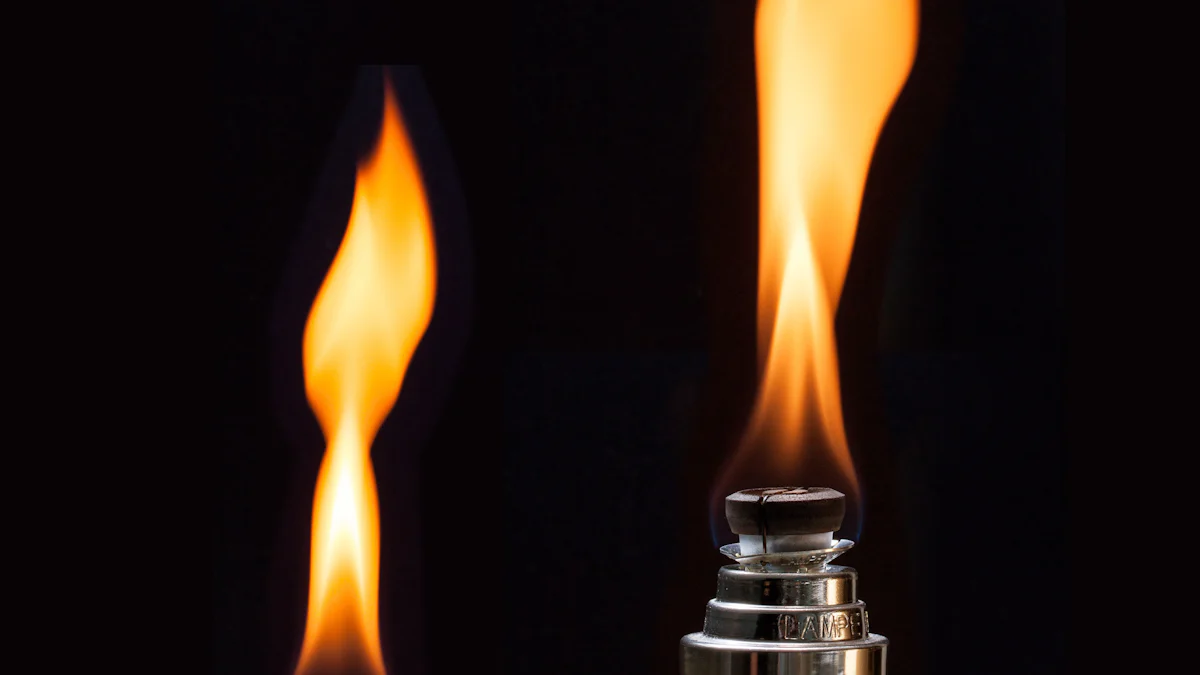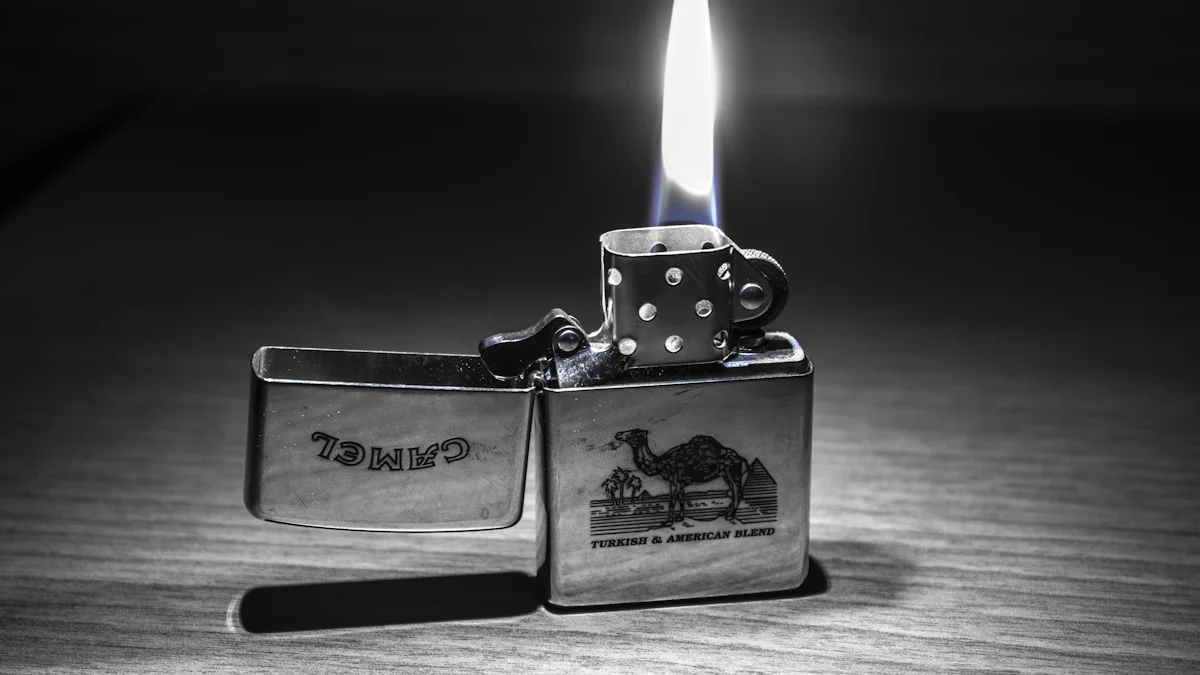
Lighters represent a remarkable achievement in human innovation. They evolved from basic fire-starting tools into sophisticated devices. Their creation involves intricate processes that highlight human ingenuity. Lighter making combines science and craftsmanship to produce reliable tools for generating flames. These devices continue to play a vital role in daily life and culture.
Key Takeaways
- Lighters started as simple fire tools and became modern gadgets.
- Ferrocerium, used in lighters, makes hot sparks for better use.
- Using reusable or USB lighters cuts waste and helps the planet.
The Historical Evolution of Lighters

Early Fire-Making Tools and Techniques
Humans have relied on fire for survival for thousands of years. Early fire-making tools included flint stones, steel, and tinder. People struck flint against steel to create sparks, which ignited the tinder. This method required skill and patience. Over time, individuals developed more efficient techniques, such as using bow drills or fire pistons. These tools compressed air to generate heat, igniting a small flame. These early innovations laid the foundation for modern lighter making.
The Invention of Döbereiner’s Lamp
In 1823, German chemist Johann Wolfgang Döbereiner introduced a groundbreaking device called Döbereiner’s Lamp. This invention used a chemical reaction between hydrogen gas and platinum to produce a flame. The lamp operated by releasing hydrogen gas from a zinc and sulfuric acid reaction. When the gas came into contact with platinum, it ignited. Although the lamp was bulky and impractical for everyday use, it marked a significant step in the evolution of lighters. It demonstrated how chemical reactions could simplify fire creation.
From Flintlock Pistols to Modern Lighters
The transition from flintlock pistols to modern lighters showcased human ingenuity. Flintlock mechanisms, originally designed for firearms, inspired early lighter designs. These devices used a flint to strike steel, creating sparks to ignite gunpowder. By the 19th century, inventors adapted this mechanism for portable fire-starting tools. The development of ferrocerium, a synthetic material that produced consistent sparks, revolutionized lighter making. This innovation paved the way for compact, reliable lighters that are widely used today.
Key Technological Advancements in Lighter Making
The Introduction of Ferrocerium
Ferrocerium, often called “flint,” revolutionized lighter making. This synthetic material, invented by Austrian chemist Carl Auer von Welsbach in 1903, produces sparks when struck. Unlike natural flint, ferrocerium generates hotter and more consistent sparks. Its unique properties come from its composition, which includes iron and rare earth metals like cerium. When struck, the material oxidizes rapidly, creating a burst of heat and light. This innovation allowed lighters to become smaller, more reliable, and easier to use. Ferrocerium remains a key component in many modern lighters.
Butane and Isobutane as Fuel Sources
The introduction of butane and isobutane as fuels marked another milestone in lighter making. These gases are highly flammable and compress easily into liquid form, making them ideal for portable devices. Butane lighters became popular in the mid-20th century due to their convenience and efficiency. They produce a steady, wind-resistant flame, which is essential for outdoor use. Isobutane, a variant of butane, offers similar benefits but performs better in cold temperatures. These fuels transformed lighters into versatile tools for various environments.
Piezoelectric Sparks and Electronic Lighters
Piezoelectric technology brought a new level of innovation to lighter making. This method uses a piezoelectric crystal, such as quartz, to generate an electric spark. When compressed, the crystal produces a small voltage that ignites the fuel. This technology eliminated the need for traditional flints, making lighters more durable and reliable. Electronic lighters, which use batteries to create sparks, further advanced the design. These lighters often feature push-button ignition, offering a user-friendly experience. Piezoelectric and electronic systems highlight the continuous evolution of lighter technology.
Types of Lighters and Their Features

Reusable Lighters
Reusable lighters are designed for long-term use. These lighters often feature a durable metal or plastic casing and a refillable fuel chamber. Users can refill them with butane or lighter fluid, depending on the model. Many reusable lighters also allow for flint or wick replacement, extending their lifespan. Zippo lighters, for example, are a popular type of reusable lighter known for their windproof design and iconic click sound. These lighters appeal to individuals who value sustainability and reliability.
Disposable Lighters
Disposable lighters are inexpensive and widely available. Manufacturers design these lighters for single-use, with a limited fuel supply and non-replaceable components. They typically consist of a plastic body and a simple ignition mechanism. Bic lighters are a well-known example of disposable lighters, offering convenience and portability. While these lighters are practical for short-term needs, their environmental impact has raised concerns due to their non-recyclable nature.
Utility Lighters
Utility lighters, also called extended-reach lighters, are ideal for specific tasks. Their long, narrow necks make them perfect for lighting candles, grills, or stoves. These lighters often use butane as fuel and feature a child-resistant safety mechanism. Utility lighters provide a safe and practical solution for situations where a standard lighter might be difficult to use. Their ergonomic design ensures ease of handling.
USB Rechargeable Lighters
USB rechargeable lighters represent a modern approach to lighter making. These lighters use electricity instead of traditional fuels like butane. They generate a plasma arc or heat coil to ignite materials. Users can recharge them via a USB port, making them eco-friendly and cost-effective. USB lighters eliminate the need for disposable fuel sources, aligning with sustainability goals. Their sleek design and innovative technology appeal to environmentally conscious consumers.
The Cultural Impact and Future of Lighters
Lighters in Pop Culture
Lighters have become more than just tools for creating fire. They hold symbolic value in movies, music, and art. In films, characters often use lighters to signify rebellion, courage, or nostalgia. For example, iconic scenes in action movies frequently feature lighters igniting explosives or lighting cigarettes. Musicians also embrace lighters during live performances. Fans traditionally raise lighters to show appreciation or create a dramatic atmosphere. This practice has evolved with technology, as many now use phone flashlights instead. Collectible lighters, such as those with unique designs or brand logos, further highlight their cultural significance.
Environmental Concerns and Sustainability
The environmental impact of disposable lighters has raised concerns. Millions of plastic lighters end up in landfills or oceans each year. These non-biodegradable items contribute to pollution and harm wildlife. Sustainable alternatives, such as reusable and USB rechargeable lighters, offer solutions. These options reduce waste by eliminating the need for single-use products. Manufacturers are also exploring eco-friendly materials and fuels. By adopting greener practices, the lighter industry can minimize its environmental footprint while meeting consumer demands.
Innovations in Lighter Design
Advancements in lighter making continue to shape their future. Modern designs prioritize functionality, aesthetics, and sustainability. USB rechargeable lighters, for instance, use plasma arcs instead of traditional flames. These lighters are windproof, energy-efficient, and rechargeable. Smart lighters with built-in safety features and customizable settings are also gaining popularity. Designers experiment with materials like recycled metals and biodegradable plastics to create eco-conscious products. These innovations ensure that lighters remain relevant in a rapidly changing world.
Lighters showcase the remarkable progress of human creativity and technology. Their transformation from primitive fire-starting tools to modern devices demonstrates the importance of innovation. Lighter making reflects this ingenuity, blending science and design. As sustainability gains importance, the industry will continue to evolve, creating eco-friendly solutions for future generations.
FAQ
What is the most common fuel used in lighters?
Butane is the most common fuel. It is highly flammable, compresses easily into liquid form, and produces a steady flame suitable for various applications.
How do USB rechargeable lighters work?
USB rechargeable lighters use electricity to create a plasma arc or heat coil. Users recharge them via USB ports, making them eco-friendly and cost-effective.
Are disposable lighters recyclable?
Most disposable lighters are not recyclable due to their plastic and metal components. They often end up in landfills, contributing to environmental pollution.
Tip: Opt for reusable or USB rechargeable lighters to reduce waste and support sustainability.


